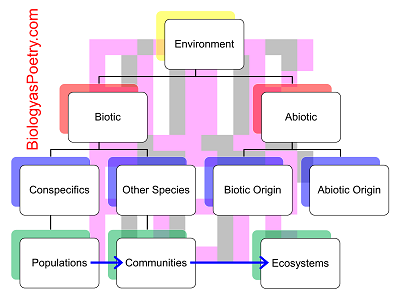∞ generated and posted on 2016.08.20 ∞
Combined biotic and abiotic components of an environment where the environment is a reasonably well delineated subset of the biosphere.
By well delineated I mean that ecosystems have non-arbitrary boundaries, such as the edges of a pond (as an ecosystem) or the edges of a forest or those of a field. Note that these boundaries are not necessarily abrupt.

Figure legend: Different levels of ecological study with so-called 'organismal ecology' at the bottom and consideration of the entire biosphere at the top. To the left and right are indications of what, in broad terms, is considered at each level with 'n' a description of number of species meaning, essentially, 'more than one'.

Figure legend: Environments can be distinguished into biotic as well as abiotic components, both of which can be further subdivided or, indeed, conceptually recombined into ecosystems.
Ecosystems thus include ponds, forests, farmland, and even our own bodies, which host numerous microorganisms. Landscapes can consist of multiple ecosystems, e.g., a field, a forest, and a pond.
The following video provides a very basic introduction to nutrient cycling and energy flow, both crucial aspects of ecosystem functioning: